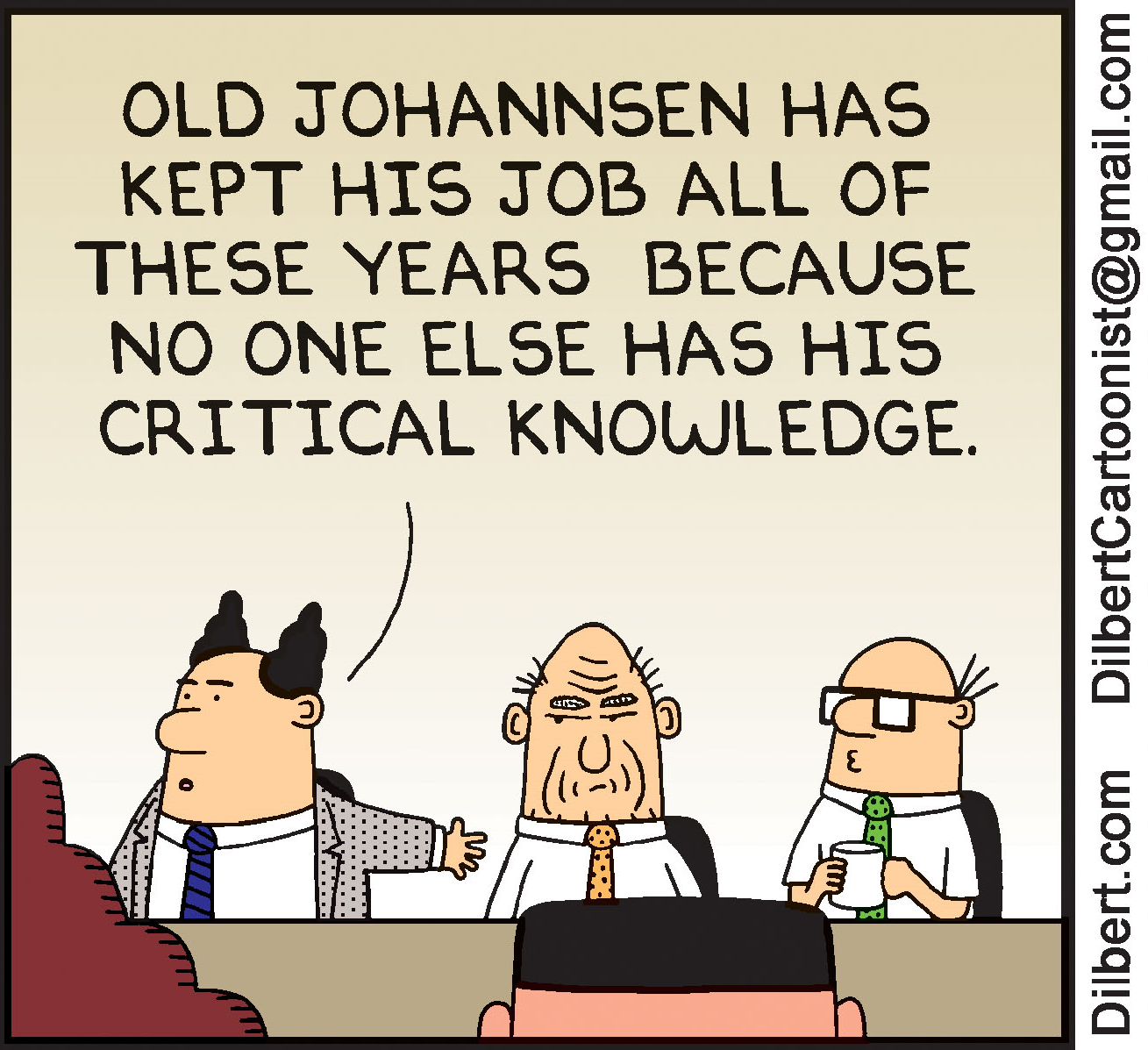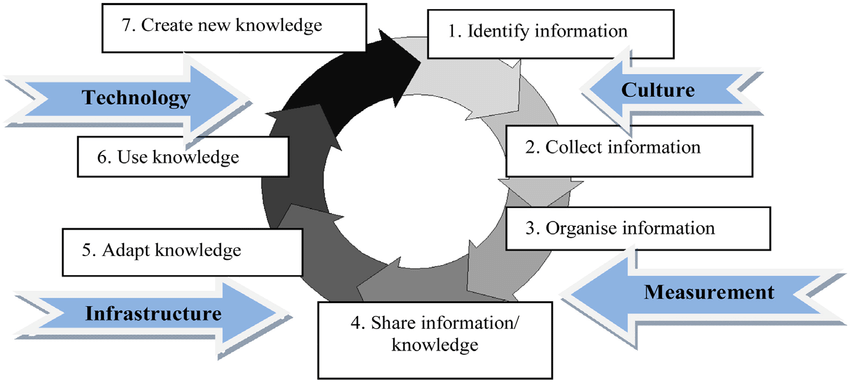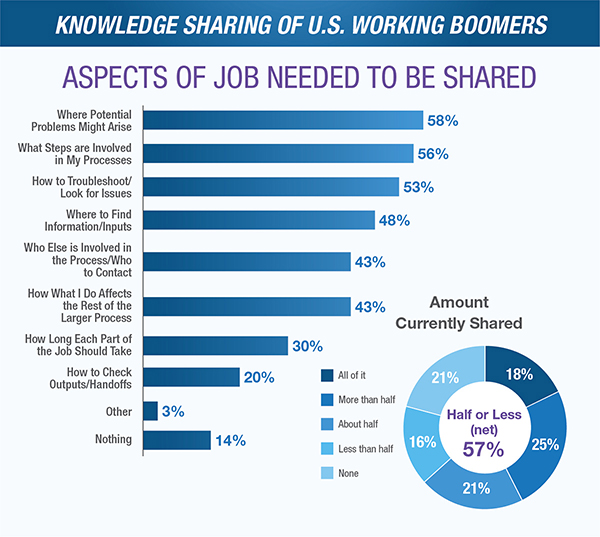
Whether your business is big or small, it’s likely that one of your important daily tasks includes communicating with your team. If you have several departments, it’s even more essential that the right information flows to the right people.
Getting your “wires crossed”, so to speak, can cause organizational delays, major miscommunications, and even prospects falling through the cracks. These issues can be greatly detrimental to your business.
Having a straightforward system for communication and collaboration is the key to avoiding these issues.
Knowledge transfer systems aid you in streamlining your knowledge which ensures that everyone on your team has the information they need to keep your business running smoothly.
 (Source)
(Source)
What is Knowledge Transfer?
“Knowledge Transfer” is a practical method for transitioning knowledge from one part of your business to another.
It is both a theory and a practice – which means that it can be applied to your company culture and to your business systems.
It is more than just communication, though. It involves the circulation of information, ideas, tasks, processes, tools, documents, and so much more.
What Knowledge Transfer is NOT
Knowledge transfer is not the same as “training”. Neither is it simply the circulation of information (facts and data).
While it does include these things, knowledge transfer has more to do with identifying and harnessing your team members’ adaptable skills and abilities to apply information.
It’s also difficult to transfer personal, experiential knowledge from one person to another. So, knowledge transfer does its best to combine both the practical with the personal in order to shift team behavior and grow their skills.
Why Knowledge Transfer Matters for Your Business Problem Solving
Have you ever come up with a great idea, just to struggle to figure out how to put it down on paper?
When it comes to innovation and problem solving, it can be hard to convert abstract concepts into an actual game plan. Beyond that, you need to figure out a way to apply that idea to the task at hand.
Sharing knowledge is tricky because it involves quantifying and qualifying knowledge that exists in the mind. A knowledge transfer system helps you translate that knowledge into words, visuals, and processes that can then be shared with your team.
A Perfectly Imperfect Approach to Problem Solving
Knowledge transfer matters for your business because it improves innovation, collaboration, and understanding in your business. Rather than relying on facts and data to share information across departments, you’re better able to paint a holistic picture of complicated concepts.
Since we are talking about knowledge – something rather intangible – this is a perfectly imperfect process. You can’t get your team to read your mind… but you can get close.
Uses of Knowledge Transfer
Knowledge transfer can help your business in the following ways:
- Accelerate the accumulation and dissemination of knowledge across your organization
- Provide easy and rapid knowledge access to your team
- Eliminate time and space constraints in communications
- Stimulate associates to experience the value of sharing knowledge in providing custom-tailored service to customers
- Respect the dignity of each individual by cultivating an environment that enhances his or her professional development and recognizes each person as a valued member of a service-oriented team
The application of knowledge transfer to your business rings in many other benefits as well, including: improved company culture, improved quality of service, faster business processes, increased efficiency, and better use of business technology and resources.
In fact, one source found that businesses that implemented a knowledge transfer system saw a 50% rise in sales while experiencing a decrease in the cost of training.
If you’re looking for a way to improve company efficiency, inspire innovation, and reduce costly miscommunications, then it’s worth building a knowledge transfer plan.
How to Do Knowledge Transfer Effectively
So, how does one actually transfer knowledge?
Since knowledge exists in the mind, the best way to transfer knowledge within an organization is to start with considering how knowledge is transferred from one person to another.
There are multiple approaches one can take here: writing, telling, or showing. The method you use depends both on how you communicate and how the other person receives information.
Therefore, when transferring knowledge across multiple areas/personnel, you’ll want to employ a variety of approaches and tools.
 (Source)
(Source)
An effective knowledge transfer strategy combines technology, culture, measurement, and infrastructure in order to share knowledge across multiple areas in your organization.
By employing multiple methods and technologies, you’ll be better able to communicate knowledge to different types of people with different skill sets.
Below we have broken the knowledge transfer process into 5 steps, including the applicable tools for each.
Step 1: Identify & Collect Knowledge
The process all starts with the cultivation of knowledge. This takes place in the culture of your company.
This often looks like:
- Brainstorming ideas
- Learning new skills
- Inviting in experts or consultants
- Seeking solutions to problems
- Designing new projects
These result in the “intangible” knowledge that you will next want to collect, document, and share with your team.
To create a strong culture of knowledge generation in your company, you can:
- Bring up company problems and seek solutions
- Document those solutions
- Seek input from team members and outsiders
- Encourage collaboration and teamwork
- Mentor and coach staff
- Train and develop staff
Your goal is to create a factory of ideas and an environment that encourages innovation – where everyone has the opportunity to share their ideas, input, and expertise.
Step 2: Capture & Store Knowledge
When it comes to documenting and sharing knowledge, a lot of businesses believe they have this on lock.
But proper knowledge capture and knowledge management is more than just having a file cabinet or Google Drive folders. You must have an infrastructure that makes sense for your business and makes access to that knowledge fast and simple.
Having a knowledge base in place will help you manage both tacit knowledge as well as explicit knowledge that’s being generated in your company.
This system may include:
- Reports
- Visuals and videos
- Document libraries
- Knowledge portals
- CRM systems
- A dedicated team
With the right knowledge management tools, you make this information readily accessible to anyone on your team that needs it. That means less delay in information changing hands, better organization, and a huge increase in efficiency.
Build a “No-Brainer” Knowledge Base with Helpjuice. Sign Up For a 14-Day Free Trial!
Step 3: Transfer & Share Knowledge
Now that you have the knowledge and have a system for collection, it’s time to circulate that information to other people and/or departments in your organization.
This knowledge transition process is made more efficient and affordable if you use the right technology.
You’ll want to design a sharing mechanism to facilitate transfer AND create a knowledge transfer plan.
The main components of this include:
- A clearly outlined process document for how knowledge is to be shared in your company.
- Technology such as a document management system, wiki software, or knowledge base software that organizes the knowledge and potentially automates knowledge sharing.
- Internal communication software that facilitates collaboration and communication.
- A dedicated person or persons to circulate the knowledge to the appropriate department(s).
- A follow-up process to confirm that the information was delivered to the right people in the right way at the right time.
Now, what this process looks like will depend on a variety of factors – from your business structure to the size of your team to your budget available for tools and resources.
Therefore, your best bet is to work with an operations expert in combination with a reliable knowledge base software to create the right system for you.
This will ensure that the knowledge is circulated effectively and efficiently.
Step 4: Apply Knowledge & Measure Results
The next step is to apply this knowledge and measure the results.
You can use Knowledge Management tools to assess success across multiple key performance indicators (KPIs).
For example, if the knowledge shared was regarding a solution to an important business problem – say, improving follow-up to leads dropping off at one stage of the sales cycle – you will want the appropriate team (in this case, Sales), to apply the solution and the report on the results.
Tools like Hubspot and Pipedrive give you the ability to track the progress of tasks, set benchmarks, and measure your success. This is the best way to know if the knowledge is being put to good use and is paying off.
Whether the results are good, poor, or okay, this should also be recorded and then communicated to the appropriate people. See how the knowledge cycle continues? With this system, you’ll never miss a beat.
Step 5: Create New Knowledge
Assume you discover that a new idea, technology, or solution is paying off. You can then apply this to other areas within your company. If the results are coming up short, on the other hand, this presents a new opportunity to innovate.
Having a knowledge transfer system ensures that your business is never stagnant when it comes to new ideas and problem-solving.
If you want your business to grow, you’ll want to cultivate an environment that encourages the constant pursuit of knowledge.
Create a Knowledge Transfer Plan for Your Business
In Step 4 we mentioned the need to create a solid knowledge transfer plan. While this will differ from business to business, there are basic components worth considering.
Identify the key knowledge holders in your organization. Does the knowledge “trickle down” from the top? Or are the true visionaries the ones in the trenches? Give the right people the opportunity to share the knowledge they have.
Motivate them to share. Encourage your “idea people” and internal experts to share their knowledge. Give them a platform to do that – whether that be through a communication channel like Slack, by giving them the floor during company meetings, or providing some other medium.
Make sharing easy. Have fast and simple tools available for people and departments to share information.
Measure results consistently. Set standards and benchmarks. Monitor progress. Communicate the results to your keep. Be receptive to input and adjust when necessary.
Apply the knowledge. Don’t let your business sleep on the knowledge available. What use is a good idea if it isn’t put into action. Offer incentives your team members to be innovative and take initiative. Encourage taking appropriate risks.
Continue generating knowledge. Bring in industry experts, offer training, hold brainstorm sessions, and otherwise encourage a community that pursues knowledge. If there is a problem, take it to your team to think up a solution. Don’t be a company that says, “We have always done it this way”. Look for different ways to do things.
Ready to improve your company culture, boost innovation, and increase collaboration in your company? Try a free 14-day trial of Helpjuice and discover how our knowledge base software facilitates easy access and transfer of your employees' insights and knowledge across teams.





